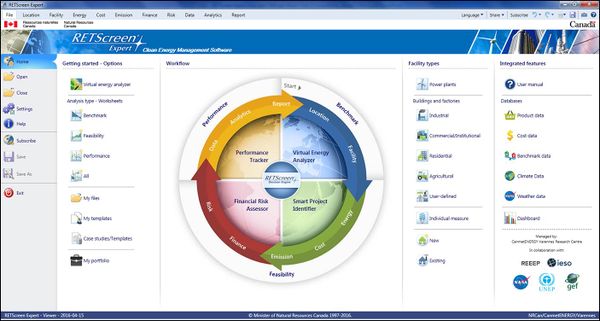Mastering Renewable Energy System Modeling and Simulation in RETScreen: A Comprehensive Guide

Introduction: RETScreen is a powerful software tool developed by Natural Resources Canada for modeling, analyzing, and optimizing renewable energy systems and energy efficiency projects. It provides a user-friendly interface and a wide range of analytical tools for evaluating the technical and financial feasibility of renewable energy projects, including solar photovoltaic (PV), wind, biomass, hydropower, and geothermal systems. In this comprehensive guide, we will explore the principles, methodologies, and best practices of modeling and simulating renewable energy systems in RETScreen, empowering users to make informed decisions and maximize the benefits of clean energy investments.
Section 1: Introduction to RETScreen
1.1 Overview of RETScreen: RETScreen is a free, comprehensive software platform designed to support decision-making processes related to renewable energy and energy efficiency projects. It provides a suite of tools for energy modeling, project evaluation, financial analysis, and performance monitoring, making it an indispensable resource for professionals and stakeholders involved in renewable energy development and sustainability initiatives.
1.2 Key Features and Capabilities: Explore the key features and capabilities of RETScreen, including energy modeling modules, weather data analysis tools, project databases, financial calculators, and customizable reports. Understand how RETScreen integrates technical, economic, and environmental analysis to assess the viability and sustainability of renewable energy projects across different geographic locations and climatic conditions.
Section 2: Getting Started with RETScreen
2.1 Installing RETScreen: Download and install RETScreen on your computer from the official website or through authorized distribution channels. Follow the installation instructions and system requirements to ensure compatibility and functionality of the software on your operating system.
2.2 Navigating the User Interface: Familiarize yourself with the RETScreen user interface and navigation tools, including menus, toolbars, panels, and dialog boxes. Learn how to access different modules, load project templates, import data, and customize settings to suit your preferences and project requirements.
Section 3: Modeling Renewable Energy Systems
3.1 Solar PV System Modeling: Model and simulate solar photovoltaic (PV) systems in RETScreen using the Photovoltaic Project Model module. Input project parameters, such as PV module specifications, system layout, orientation, tilt angle, shading factors, and meteorological data, to estimate energy production, system performance, and financial metrics for solar PV projects.
3.2 Wind Energy System Modeling: Model and simulate wind energy systems in RETScreen using the Wind Energy Project Model module. Define wind turbine characteristics, site-specific wind conditions, turbine layout, hub height, rotor diameter, and other parameters to assess wind resource potential, turbine performance, energy output, and economic feasibility for wind energy projects.
3.3 Biomass, Hydropower, and Geothermal System Modeling: Explore additional renewable energy modeling modules in RETScreen for biomass, hydropower, and geothermal energy systems. Input project data, such as feedstock characteristics, water flow rates, turbine specifications, and geothermal reservoir properties, to analyze resource availability, system performance, and economic viability for these renewable energy technologies.
Section 4: Project Evaluation and Financial Analysis
4.1 Technical Analysis: Conduct technical analysis of renewable energy projects in RETScreen to assess system performance, energy production, and environmental impacts. Use simulation results, performance indicators, and sensitivity analysis tools to evaluate project alternatives, optimize design parameters, and mitigate risks associated with renewable energy investments.
4.2 Financial Analysis: Perform financial analysis of renewable energy projects in RETScreen to evaluate their economic viability and financial attractiveness. Estimate project costs, revenues, cash flows, net present value (NPV), internal rate of return (IRR), payback period, and other financial metrics to assess investment returns, financial risks, and profitability of renewable energy ventures.
4.3 Sensitivity Analysis and Risk Assessment: Conduct sensitivity analysis and risk assessment in RETScreen to evaluate the impact of uncertainty, variability, and risk factors on project outcomes. Identify key variables, input parameters, and assumptions that influence project economics and performance, and analyze their sensitivity to changes in market conditions, technology costs, and regulatory policies.
Section 5: Reporting and Documentation
5.1 Generating Reports: Generate comprehensive reports and documentation for renewable energy projects in RETScreen to communicate analysis results, findings, and recommendations to stakeholders and decision-makers. Customize report templates, add project data, charts, and tables, and export reports in various formats, such as PDF, Excel, and Word, for sharing and presentation purposes.
5.2 Project Documentation: Organize and manage project documentation, data files, and analysis results in RETScreen’s project database. Create project folders, store project files, input data, and calculation results, and maintain project records for future reference, audit, and collaboration with project team members and stakeholders.
Section 6: Case Studies and Best Practices
6.1 Case Studies: Explore real-world case studies and examples of renewable energy projects analyzed and modeled using RETScreen. Learn from successful project implementations, best practices, lessons learned, and innovative solutions in renewable energy development and sustainability initiatives across different sectors and geographic regions.
6.2 Best Practices: Implement best practices and guidelines for modeling and simulating renewable energy systems in RETScreen. Follow standardized procedures, quality assurance protocols, and industry benchmarks for data collection, input validation, model calibration, sensitivity analysis, and documentation to ensure accuracy, reliability, and transparency in project evaluation and decision-making processes.
Conclusion: Modeling and simulating renewable energy systems in RETScreen provide stakeholders with valuable insights and decision support tools for evaluating the technical, economic, and environmental feasibility of clean energy projects. By mastering the principles, methodologies, and best practices outlined in this guide, users can leverage RETScreen’s analytical capabilities to assess renewable energy resources, optimize system design, and maximize the benefits of clean energy investments. With its user-friendly interface, powerful modeling tools, and comprehensive analysis features, RETScreen empowers professionals and organizations to accelerate the adoption of renewable energy technologies, mitigate climate change impacts, and transition towards a sustainable and resilient energy future.




